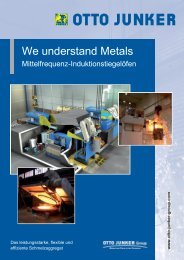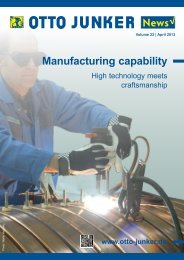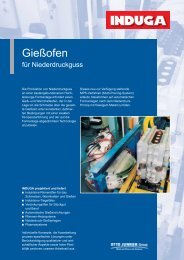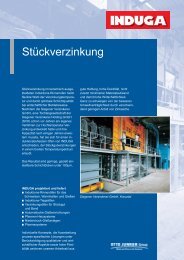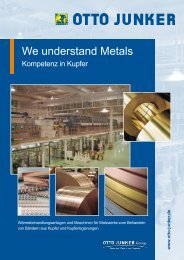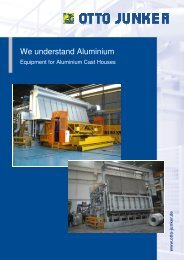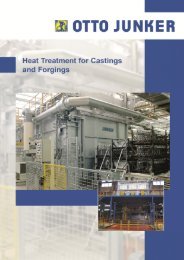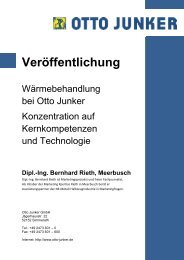Konzentration auf Kernkompetenzen und Technologie - Otto Junker ...
Konzentration auf Kernkompetenzen und Technologie - Otto Junker ...
Konzentration auf Kernkompetenzen und Technologie - Otto Junker ...
Erfolgreiche ePaper selbst erstellen
Machen Sie aus Ihren PDF Publikationen ein blätterbares Flipbook mit unserer einzigartigen Google optimierten e-Paper Software.
A L U M I N I U M w a l z I N D U S T R i e<br />
Wärmebehandlung bei <strong>Otto</strong> <strong>Junker</strong><br />
<strong>Konzentration</strong> <strong>auf</strong> <strong>Kernkompetenzen</strong> <strong>und</strong> <strong>Technologie</strong><br />
B. Rieth, Meerbusch<br />
Im Geschäftsbereich „Thermoprozessanlagen“<br />
hat <strong>Otto</strong> <strong>Junker</strong><br />
eine neue Strategie umgesetzt:<br />
Die Standorte von Beteiligungen<br />
der deutschen <strong>Otto</strong> <strong>Junker</strong> GmbH<br />
an verschiedenen Unternehmen<br />
des metallurgischen Anlagenbaus<br />
– wie Thermcon in den Niederlanden,<br />
IUT in Schweden sowie<br />
Elhaus <strong>und</strong> Induga in Deutschland<br />
<strong>und</strong> der Schweiz – wurden<br />
geschlossen <strong>und</strong> das Know-how<br />
zusammen mit wichtigen Mitarbeitern<br />
am Stammwerk von<br />
<strong>Otto</strong> <strong>Junker</strong> in Lammersdorf<br />
zusammengeführt. Mit dieser verschlankten<br />
Struktur präsentiert<br />
sich <strong>Otto</strong> <strong>Junker</strong> als <strong>Technologie</strong>unternehmen,<br />
das sich im Aluminiumgeschäft<br />
<strong>auf</strong> seine <strong>Kernkompetenzen</strong><br />
fokussiert.<br />
„Hier in Lammersdorf haben wir<br />
einzigartige Möglichkeiten, neue<br />
Wärm- <strong>und</strong> Schmelztechnologien zu<br />
entwickeln, die dem Unternehmen<br />
ein langfristiges Wachstum sichern“,<br />
erläutert Hans Rinnhofer, seit zwei<br />
Jahren Vorsitzender der Geschäftsführung<br />
der <strong>Otto</strong> <strong>Junker</strong> GmbH. Ergänzend<br />
führt er aus: „Wir verstehen<br />
uns als eine Firma, die aus dem Industrieofen-Anlagenbau<br />
kommt <strong>und</strong><br />
in den über 85 Jahren ihres Bestehens<br />
umfangreiche Kompetenzen <strong>auf</strong> den<br />
Gebieten der Thermoprozesstechnik<br />
sowie des Schmelzens <strong>auf</strong>gebaut hat<br />
<strong>und</strong> aus dem Verständnis der Verfahrenstechnik<br />
ihre Wettbewerbsvorteile<br />
schöpft“.<br />
Das Unternehmen sieht sich dabei<br />
als Anlagenbauer mit <strong>Kernkompetenzen</strong><br />
in der Industrieofentechnik<br />
<strong>und</strong> dem Projektmanagement. Darüber<br />
hinaus betreibt <strong>Otto</strong> <strong>Junker</strong> am<br />
Hauptstandort eine eigene Edelstahlgießerei.<br />
„Wir sind in der Lage, komplette<br />
Hüttengießereien anzubieten,<br />
wobei wir aber mit Partnerfirmen<br />
kooperieren, die Spezialgebiete abdecken,<br />
wie etwa Stranggießanlagen<br />
für Walzbarren oder Pressbolzen“, so<br />
Rinnhofer.<br />
Heat treatment with <strong>Otto</strong> <strong>Junker</strong><br />
Focus on core competences and technology<br />
B. Rieth, Meerbusch<br />
In its ‘thermo-process equipment’<br />
business sector <strong>Otto</strong> <strong>Junker</strong> has<br />
adopted a new strategy: the sites<br />
of participations by Germany’s<br />
<strong>Otto</strong> <strong>Junker</strong> GmbH in various<br />
metallurgical plant engineering<br />
companies – such as Thermcon in<br />
the Netherlands, IUT in Sweden<br />
and Elhaus and Induga in Germany<br />
and Switzerland – have been<br />
closed and the know-how, together<br />
with important staff members,<br />
brought together at <strong>Otto</strong> <strong>Junker</strong>’s<br />
main location in Lammersdorf.<br />
With this slimmed-down structure<br />
<strong>Otto</strong> <strong>Junker</strong> presents itself as a<br />
technology company focused on<br />
its core competences in the aluminium<br />
sector.<br />
“Here in Lammersdorf we have unique<br />
possibilities for developing new heat<br />
treatment and melting technologies<br />
which should ensure long-term<br />
Rückseitige Ansicht eines neu gelieferten Stoßofens während der<br />
Montage<br />
Abbildungen: <strong>Otto</strong> <strong>Junker</strong><br />
Rear view of a newly delivered pusher furnace during assembly<br />
growth for the company”, explains<br />
Hans Rinnhofer, for the past two years<br />
CEO of <strong>Otto</strong> <strong>Junker</strong>. And he adds:<br />
“We regard ourselves as a company<br />
with its origins in industrial furnace<br />
engineering, which during the more<br />
than 85 years of its existence has accumulated<br />
extensive expertise in the<br />
field of thermal process technology<br />
and melting, and which derives its<br />
competitive advantages from an <strong>und</strong>erstanding<br />
of process technology.”<br />
The company, then, regards itself<br />
as a plant engineering group with core<br />
competences in industrial furnace<br />
technology and project management.<br />
In addition, at its main location <strong>Otto</strong><br />
<strong>Junker</strong> operates a stainless steel fo<strong>und</strong>ry<br />
of its own. “We can offer complete<br />
casthouses, but we also co-operate<br />
with partner firms that can cover special<br />
fields, as for example continuous<br />
casting machines for rolling slabs or<br />
extrusion billets”, says Rinnhofer.<br />
Similarly, besides melting and casting<br />
furnaces <strong>Otto</strong> <strong>Junker</strong> also supplies<br />
heat technology equipment such as<br />
heating and heat treatment furnaces<br />
for semis, castings<br />
and forged<br />
components, as<br />
well as the associated<br />
loading<br />
and unloading<br />
equipment.<br />
The Technology<br />
Centre<br />
in Lammersdorf<br />
does not only<br />
have staff specialised<br />
in the<br />
field of heat<br />
treatment. In a<br />
laboratory for<br />
induction melting<br />
furnaces<br />
and a technical<br />
unit for heat processes new ideas are<br />
investigated for their feasibility in 1:1<br />
practical tests, and optimised. “Not<br />
many industrial furnace manufactur-<br />
28 ALUMINIUM · 10/2010
S P E C I A L<br />
A L U M I N I U M w a l z I N D U S T R i e<br />
A L U M I N I U M r o l l i n g I N D U S T R Y<br />
ers have the possibility to carry out<br />
development work on the industrial<br />
scale and, for example, to compare<br />
mathematical models with physical<br />
reality so that we can present our<br />
customers with concrete results”, says<br />
Rinnhofer.<br />
Another major asset of the location<br />
is its proximity to the Rhine-Westphalia<br />
Technical University (RWTH)<br />
in Aachen. ‘Proximity’ does not just<br />
refer to the barely 30 kilometres between<br />
Lammersdorf and Aachen. The<br />
fo<strong>und</strong>er, Dr. E. h. <strong>Otto</strong> <strong>Junker</strong> (1900 to<br />
1982), being without issue, endowed<br />
a fo<strong>und</strong>ation while he was still alive,<br />
in 1970, whose sole purpose is to promote<br />
RWTH in the technical fields of<br />
metallurgy and electro-technology in<br />
the context of research projects. The<br />
<strong>Otto</strong> <strong>Junker</strong> Fo<strong>und</strong>ation is today one<br />
of the major private benefactors of<br />
this renowned university. That fact<br />
has resulted in an extremely fruitful<br />
co-operation with the relevant faculties<br />
of RWTH, which is reflected on<br />
the one hand in industry-related requests<br />
to the institute for practical<br />
problem solutions and on the other<br />
hand in continual feedback of new engineering<br />
competence to <strong>Otto</strong> <strong>Junker</strong>.<br />
By focusing on its core competences<br />
the company managed, even when<br />
the economic crisis was beginning, to<br />
acquire technologically demanding<br />
contracts which helped to cushion<br />
the impact of the worldwide downturn<br />
of orders last year and provide<br />
continuity with the now recovering<br />
trade situation. Whereas China and<br />
South America brought the company<br />
some interesting projects in the sector<br />
of copper plants, the aluminium<br />
sector benefited from technically demanding<br />
orders from other economic<br />
areas. As an example, increasing the<br />
throughput of an existing pusher furnace<br />
at a major French can stock manufacturer<br />
can be mentioned. This will<br />
be done not by the usual lengthening<br />
of the furnace zone, but by a unit for<br />
the selective cooling of the rolling<br />
slabs. This frees up the furnace several<br />
hours earlier for the next heating<br />
operation, while the selectively controlled<br />
cooling to rolling temperature<br />
of the slabs previously heated to the<br />
homogenisation temperature takes<br />
place in external cooling and ➝<br />
Gasinstallation zur Brennerregelung <strong>auf</strong> der Ofendecke<br />
Gas installation for burner regulation, on the roof of the furnace<br />
Ähnlich liefert <strong>Otto</strong> <strong>Junker</strong> neben<br />
Schmelz- <strong>und</strong> Gießöfen auch die wärmetechnischen<br />
Anlagen wie Anwärm<strong>und</strong><br />
Wärmebehandlungsöfen für<br />
Halbzeuge, Guss <strong>und</strong> Schmiedeteile<br />
sowie die zugehörigen Beschickungs<strong>und</strong><br />
Entnahmeeinrichtungen.<br />
Das <strong>Technologie</strong>zentrum in Lammersdorf<br />
verfügt nicht nur über spezialisierte<br />
Fachleute <strong>auf</strong> dem Gebiet der<br />
Wärmebehandlung. In einem Labor<br />
für Induktions-Schmelzöfen sowie in<br />
einem Technikum für Wärmprozesse<br />
werden neue Ideen mit 1:1-Praxisversuchen<br />
<strong>auf</strong> ihre Realisierbarkeit<br />
hin untersucht <strong>und</strong> optimiert. „Die<br />
Möglichkeit im Praxismaßstab zu entwickeln<br />
<strong>und</strong> zum Beispiel mathematische<br />
Modelle mit der physikalischen<br />
Wirklichkeit abzugleichen sowie<br />
unseren K<strong>und</strong>en Ergebnisse präsentieren<br />
zu können haben nicht viele<br />
Industrieofenbauer“, so Rinnhofer.<br />
Was den Standort darüber hinaus<br />
auszeichnet, ist seine Nähe zur Rheinisch-Westfälischen<br />
Technischen<br />
Hochschule (RWTH) in Aachen. Mit<br />
„Nähe“ sind nicht nur die knapp 30<br />
Kilometer Entfernung von Lammersdorf<br />
nach Aachen gemeint. Der Gründer<br />
Dr. E. h. <strong>Otto</strong> <strong>Junker</strong> (1900 bis<br />
1982) hatte, da ohne Nachkommen,<br />
neben der <strong>Otto</strong> <strong>Junker</strong> GmbH noch zu<br />
Lebzeiten im Jahre 1970 eine Stiftung<br />
gegründet, die keine andere Aufgabe<br />
hat, als die RWTH in den Fachbereichen<br />
Metallurgie <strong>und</strong> Elektrotechnik<br />
im Rahmen von Forschungsprojekten<br />
zu fördern. Die <strong>Otto</strong> <strong>Junker</strong> Stiftung<br />
ist heute einer der großen privaten<br />
Einzelförderer dieser renommierten<br />
Hochschule. Dieser Umstand mündet<br />
in eine äußerst fruchtbare Zusammenarbeit<br />
mit den relevanten<br />
Lehrstühlen der RWTH, die sich in<br />
praxisnahe Aufgabenstellungen an<br />
das Institut einerseits widerspiegelt<br />
<strong>und</strong> in einem ständigen Zufluss neuer<br />
Ingenieurkompetenz zu <strong>Otto</strong> <strong>Junker</strong><br />
andererseits.<br />
Mit der <strong>Konzentration</strong> <strong>auf</strong> <strong>Kernkompetenzen</strong><br />
ist es dem Unternehmen<br />
gelungen, noch zu Beginn der<br />
Wirtschaftskrise technologisch anspruchsvolle<br />
Aufträge zu akquirieren.<br />
Diese halfen, den weltweiten<br />
Auftragsrückgang 2009 abzufedern<br />
<strong>und</strong> Anschluss an die sich nun wieder<br />
belebende Konjunktur zu finden.<br />
Während China <strong>und</strong> Südamerika<br />
dem Unternehmen einige interessante<br />
Projekte <strong>auf</strong> dem Sektor von<br />
Kupferanlagen brachten, profitiert<br />
der Aluminiumbereich von technisch<br />
anspruchsvollen Aufträgen aus anderen<br />
Wirtschaftsregionen. Beispielhaft<br />
sei die Durchsatzerhöhung an einem<br />
bestehenden Stoßofen eines großen<br />
französischen Dosenbandherstellers<br />
genannt. Diese wird nicht durch die<br />
sonst übliche Verlängerung der Ofenzonen,<br />
sondern mit einer Anlage zur<br />
gezielten Abkühlung der Walzbarren<br />
erreicht. Hierdurch wird der ➝<br />
ALUMINIUM · 10/2010<br />
29
A L U M I N I U M w a l z I N D U S T R i e<br />
Ofen um mehrere St<strong>und</strong>en früher für<br />
den folgenden Anwärmbetrieb frei,<br />
während die gezielt gesteuerte Abkühlung<br />
<strong>auf</strong> Walztemperatur der zuvor<br />
<strong>auf</strong> Homogenisierungstemperatur<br />
erwärmten Barren in externen Kühl<strong>und</strong><br />
Ausgleichskammern geschieht.<br />
„Die erforderliche <strong>Technologie</strong> der<br />
Oberflächenabkühlung <strong>und</strong> anschließende<br />
Erholung aus der Kerntemperatur<br />
konnten wir für den K<strong>und</strong>en<br />
überzeugend aus unserer langjährigen<br />
Erfahrung beim Bau von Plattenabschreckanlagen<br />
ableiten“, berichtet<br />
Bernd Deimann, verantwortlich<br />
für Projektierung <strong>und</strong> Verk<strong>auf</strong><br />
von Wärmebehandlungsanlagen für<br />
Leichtmetall.<br />
Ein bekanntes Folienwalzwerk in<br />
Südeuropa erhält von <strong>Otto</strong> <strong>Junker</strong><br />
demnächst zwei Folienglühöfen, die<br />
weltweit gesehen den vergleichsweise<br />
geringsten Energieverbrauch <strong>auf</strong>weisen<br />
werden. Die Öfen sind für alle<br />
Arten von Folienprodukten sowie für<br />
Bandb<strong>und</strong>e ausgelegt. Auch hier setzt<br />
<strong>Otto</strong> <strong>Junker</strong> eine Weiterentwicklung<br />
aus seinem <strong>Technologie</strong>zentrum ein:<br />
Um den Ofen zeitlich <strong>und</strong> energetisch<br />
optimal zu betreiben, berechnet ein<br />
mit der Ofensteuerung online verb<strong>und</strong>enes<br />
mathematisches Modell den<br />
thermischen Zustand der Bandb<strong>und</strong>e<br />
<strong>und</strong> der Öfen. Mit den berechneten<br />
Parametern werden die Öfen optimiert<br />
betrieben, was sich in verkürzten<br />
Glühzyklen <strong>und</strong> reduzierten Energieverbrauchswerten<br />
niederschlägt.<br />
Ein hochwirksamer Wärmetauscher<br />
sorgt für eine Vorwärmung der Spülluft<br />
zur Abfuhr der verdunstenden<br />
Walzölgehalte, was sich in einem<br />
deutlich gesenkten Energieverbrauch<br />
ausdrücken wird.<br />
Die Vielfalt der einsetzbaren <strong>Otto</strong><br />
<strong>Junker</strong>-<strong>Technologie</strong>n zeigt sich auch<br />
bei einem anderen aktuellen Auftrag.<br />
So hat ein führender italienischer<br />
Hersteller von Fahrzeugkomponenten<br />
dem Unternehmen einen Auftrag<br />
für eine große Vergüteanlage für<br />
Automobilteile für sein neues Werk<br />
in Tschechien erteilt. Die Anlage besteht<br />
aus einem Lösungsglühofen, der<br />
Wasserabschreckung <strong>und</strong> dem Warmauslagerungsofen,<br />
komplett mit Beschickung<br />
<strong>und</strong> Entnahme der Körbe.<br />
<strong>Otto</strong> <strong>Junker</strong> baut hier <strong>auf</strong> Erfahrungen<br />
<strong>auf</strong>, die das Unternehmen bei früher<br />
an VW Braunschweig <strong>und</strong> KSM Hildesheim<br />
gelieferten Vergüteanlagen<br />
gewonnen hat.<br />
Energieoptimierte<br />
Stoßöfen – eine neue<br />
Entwicklung von <strong>Otto</strong> <strong>Junker</strong><br />
Exemplarisch für das Innovationspotenzial<br />
von <strong>Otto</strong> <strong>Junker</strong> ist das<br />
inzwischen zum Patent angemeldete<br />
Konzept des besonders energieeffizienten<br />
Stoßofens – SLE (Side Loaded<br />
Energy Saving) Pusher Furnace – zum<br />
Anwärmen <strong>und</strong> Homogenisieren von<br />
Walzbarren vor dem Warmwalzen.<br />
Die bisherigen Konstruktionen der<br />
verschiedenen Anbieter haben eines<br />
gemeinsam: Große Türen mit je nach<br />
Anwendungsfall bis zu 30 m 2 Türfläche<br />
<strong>auf</strong> der Belade- <strong>und</strong> Entnahmeseite<br />
zum Durchstoßen der <strong>auf</strong>recht<br />
gestellten Walzbarren quer zu deren<br />
Längsachse. Die daraus resultierenden<br />
Energieverluste (Türverluste)<br />
bel<strong>auf</strong>en sich nach Messungen von<br />
<strong>Otto</strong> <strong>Junker</strong> <strong>auf</strong> ca. drei bis sechs<br />
Prozent der nutzbaren Energie, abhängig<br />
von den Ofen- <strong>und</strong> Barrenabequalisation<br />
chambers. “We were able<br />
to derive the necessary technology for<br />
surface cooling and subsequent recuperation<br />
from the core temperature<br />
from our many years of experience<br />
in the construction of plate-quenching<br />
units, in a customer-convincing<br />
way”, reports Bernd Deimann, sales<br />
manager Heat Treatment Equipment<br />
for Light Metals.<br />
A noted foil rolling mill in southern<br />
Europe is soon to receive from<br />
<strong>Otto</strong> <strong>Junker</strong> two large foil annealing<br />
furnaces, which on a worldwide view<br />
will have comparatively the lowest<br />
energy consumption. The furnaces<br />
are designed for all types of foil products<br />
and for coils. In this case too <strong>Otto</strong><br />
<strong>Junker</strong> is using a further development<br />
from its Technology Centre: to operate<br />
the furnaces optimally in terms<br />
of time and energy, a mathematical<br />
model connected online to the furnace<br />
control system calculates the thermal<br />
status of the coils and the furnaces.<br />
Using the calculated parameters the<br />
furnaces are operated optimally, resulting<br />
in shorter annealing cycles<br />
and lower energy consumption val-<br />
Das Diagramm zeigt die prozentuale Aufteilung der Energieströme für Standardstoßöfen,<br />
SLE-Stoßöfen sowie SLE-Stoßöfen mit Vorwärmkammer. Die Aufteilung des verbrauchten<br />
Heizmediums <strong>auf</strong> Nutzgut, Totgut, Wandverluste, Abgasverluste <strong>und</strong> Türverluste der drei<br />
dargestellten Fälle zeigt die verbesserte Situation des SLE-Stoßofens <strong>und</strong> insbesondere das<br />
große Potential des SLE-Stoßofens in Zusammenarbeit mit Vorwärmkammern.<br />
The diagram shows the percentage division of energy flows for standard pusher furnaces,<br />
SLE Pusher Furnaces and SLE Pusher Furnaces with a preheat chamber. The division of the<br />
heating medium consumed into aluminium, skid shoes, wall losses, exhaust gas losses<br />
and door losses in the three cases shown demonstrates the improved performance of the<br />
SLE Furnace, especially the great potential of the SLE Pusher Furnace combined with a<br />
preheat chamber.<br />
30 ALUMINIUM · 10/2010
S P E C I A L<br />
A L U M I N I U M w a l z I N D U S T R i e<br />
A L U M I N I U M r o l l i n g I N D U S T R Y<br />
ues. A highly effective heat exchanger<br />
preheats the flushing air to remove its<br />
vaporised rolling oil content, and this<br />
too reduces the energy consumption<br />
substantially.<br />
The variety of <strong>Otto</strong> <strong>Junker</strong> technologies<br />
available for use is also shown<br />
in another current contract. A leading<br />
Italian manufacturer of vehicle<br />
components has awarded the company<br />
a contract for a large tempering<br />
unit for automobile components at its<br />
new plant in the Czech Republic. The<br />
equipment comprises a solution annealing<br />
furnace, a water-quench and<br />
the ageing furnace, complete with<br />
rack loading and removal. In this case<br />
<strong>Otto</strong> <strong>Junker</strong> is building on experience<br />
gained by the company in earlier tempering<br />
plants supplied to VW Braunschweig<br />
and KSM Hildesheim.<br />
Energy-optimised<br />
pusher furnaces – a new<br />
development by <strong>Otto</strong> <strong>Junker</strong><br />
An example of the company’s innovative<br />
potential is the concept, for which<br />
a patent application has been filed, of<br />
a particularly energy-efficient pusher<br />
furnace – SLE (Side Loaded Energysaving)<br />
Pusher Furnace – for heating<br />
and homogenising rolling slabs before<br />
they are hot-rolled. Previous designs<br />
by various suppliers have one thing<br />
in common: large doors with a door<br />
area, depending on the application,<br />
of up to 30 m 2 on the loading and<br />
unloading sides, enabling the rolling<br />
slabs, positioned upright, to be pushed<br />
transversely to their long axis. According<br />
to measurements by <strong>Otto</strong> <strong>Junker</strong><br />
the resulting energy losses (door<br />
losses) amount to three to six percent<br />
of the useful energy, depending on<br />
the furnace, the slab dimensions and<br />
the process conditions. Besides these<br />
losses the furnace atmosphere is also<br />
affected by the continual opening<br />
and closing of the doors. Even slotted<br />
nozzles with aerodynamic sealing on<br />
the ends of the furnace do not give<br />
any lasting improvement.<br />
<strong>Otto</strong> <strong>Junker</strong>’s approach for a solution<br />
is very simple in principle. The<br />
slabs are no longer pushed into the<br />
furnace from the end, but from the<br />
side. The area of the door aperture<br />
is then no longer defined by the ➝<br />
30-Tonnen-Barren in der Warteposition vor dem Einschieben in einen Ofen<br />
30-tonne slab in waiting position before insertion into a furnace<br />
messungen <strong>und</strong> Prozessbedingungen.<br />
Zu den Verlusten kommen noch Störungen<br />
der Ofenatmosphäre durch<br />
das ständige Öffnen <strong>und</strong> Schließen<br />
der Türen. Auch Schlitzdüsen mit<br />
aerodynamischer Abdichtung an den<br />
Ofenstirnseiten stellen hier keine<br />
nachhaltige Verbesserung dar.<br />
Der Lösungsansatz von <strong>Otto</strong> <strong>Junker</strong><br />
ist im Prinzip ganz einfach. Er sieht<br />
vor, dass die Barren nicht mehr stirnseitig<br />
in den Ofen eingestoßen werden,<br />
sondern von der Seite. Damit definiert<br />
sich die Fläche der Türöffnung nicht<br />
mehr nach Breite <strong>und</strong> Länge der Barren,<br />
sondern nach deren Breite <strong>und</strong><br />
Dicke. Bei den gängigen Barrengrößen<br />
schrumpft die Türöffnung somit<br />
<strong>auf</strong> circa ein Zehntel der ursprünglichen<br />
Fläche. Im gleichen Maße<br />
werden die Türverluste reduziert,<br />
wobei die Einsparung dann circa<br />
zwei bis drei Prozent des Energieverbrauchs<br />
des Ofens entspricht. Die<br />
Vorgänge im Ofen bleiben unverändert,<br />
allerdings verbessert sich die<br />
Temperaturführung im Belade- <strong>und</strong><br />
Entnahmebereich durch die weniger<br />
gestörte Luftumwälzung. Neben der<br />
verbesserten Energieeffizienz ergibt<br />
sich eine leichte Durchsatzsteigerung<br />
gegenüber der konventionellen Ofenkonfiguration.<br />
Die Überlegungen des Unternehmens<br />
zur Verbesserung der Wirtschaftlichkeit<br />
von Stoßöfen gehen<br />
noch weiter: Trotz der Verwendung<br />
hoch effizienter Brenner sind die<br />
Abgasverluste der Stoßöfen spürbar<br />
hoch. Die Barrenvorwärmung in einer<br />
separaten Vorwärmkammer, die<br />
über zusätzliche Ausnutzung der<br />
Stoßofenabgase beheizt wird, könnte<br />
diese Abgasverluste drastisch verringern.<br />
<strong>Otto</strong> <strong>Junker</strong> rechnet in diesem<br />
Zusammenhang folgendes Beispiel:<br />
Die Gesamtenergie (Gas <strong>und</strong> Strom),<br />
die bei der Erwärmung im klassischen<br />
Stoßofen <strong>auf</strong>gewendet wird, liegt bei<br />
194 kWh/t Al. Mit Vorwärmung reduziert<br />
sich der entsprechende Wert<br />
bei ansonsten gleichen Bedingungen<br />
<strong>auf</strong> 162 kWh/t Al. Bei Anwendung<br />
einer entsprechend großen Barrenvorwärmung<br />
reduziert sich trotz<br />
eines elektrischen Mehrverbrauchs<br />
durch die Vorwärmkammer der Gesamtenergieverbrauch<br />
um mehr als<br />
16 Prozent. Bei abweichenden Ofen-,<br />
Barrenabmessungen variieren diese<br />
Werte entsprechend der geänderten<br />
Randbedingungen.<br />
Edelstahlgießerei profitiert<br />
von anziehender Konjunktur<br />
Neben den Thermoprozessanlagen,<br />
an deren Umsatz Aluminium im<br />
Durchschnitt mit r<strong>und</strong> 50 Prozent<br />
beteiligt ist, verfügt <strong>Otto</strong> <strong>Junker</strong> noch<br />
über zwei weitere Geschäftsbereiche:<br />
Bau von Induktionsschmelzanlagen<br />
sowie eine Edelstahlgießerei.<br />
Induktionsschmelzanlagen werden<br />
in der Aluminiumindustrie in<br />
der Anodenanschlägerei sowie zum<br />
Einschmelzen von Spänen eingesetzt.<br />
Im zweiten Fall liegt der Vor-<br />
➝<br />
ALUMINIUM · 10/2010<br />
31
A L U M I N I U M w a l z I N D U S T R i e<br />
teil gegenüber konventionellen Öfen<br />
im strömungstechnisch bedingten<br />
schnellen Einziehen der Späne unter<br />
das Bad. Da Aluminiumspäne<br />
<strong>auf</strong>gr<strong>und</strong> ihrer großen Oberfläche<br />
beim konventionellen Einschmelzen<br />
zu einer starken Oxidation neigen,<br />
kommt hier dem Induktionsofen bei<br />
zunehmendem Zerspanungsanteil<br />
eines Unternehmens im Sinne der<br />
Material- <strong>und</strong> Energieeffizienz große<br />
wirtschaftliche Bedeutung zu.<br />
Viel Freude hat <strong>Otto</strong> <strong>Junker</strong> derzeit<br />
an seiner hochspezialisierten<br />
Edelstahlgießerei, die von der weltweit<br />
wieder anziehenden Konjunktur<br />
profitiert. Dies wird unterstützt durch<br />
eine starke Spezialisierung, die neben<br />
dem Gießen auch die mechanische<br />
Präzisionsbearbeitung der Gussteile<br />
einschließt. Zu den Spezialitäten des<br />
Unternehmens zählen Maschinenbetten<br />
für Präzisions-Werkzeugmaschinen<br />
zur Herstellung von Microchips.<br />
Dank der guten Zusammenarbeit<br />
mit einem führenden Maschinenhersteller<br />
rechnet das Unternehmen<br />
mit einer nachhaltigen Positionierung<br />
in diesem Marktsegment.<br />
Autor<br />
Dipl.-Ing. Bernhard Rieth ist Marketingspezialist<br />
<strong>und</strong> freier Fachjournalist. Als<br />
Inhaber der Marketing Xpertise Rieth in<br />
Meerbusch berät er Ausrüstungspartner<br />
der NE-Metall-Halbzeugindustrie in Marketingfragen.<br />
Atilla Somuncu neuer<br />
Leiter Thermoprozessanlagen<br />
bei <strong>Otto</strong> <strong>Junker</strong><br />
Atilla Somuncu ist neuer General<br />
Manager im Geschäftsbereich Thermoprozessanlagen<br />
der <strong>Otto</strong> <strong>Junker</strong> GmbH<br />
<strong>und</strong> wird das bestehende Leitungsteam<br />
mit Dirk Menzler <strong>und</strong> Günter Valder<br />
verstärken. Er studierte Maschinenbau-<br />
Wärmetechnik an der RWTH Aachen<br />
<strong>und</strong> war anschließend sechs Jahre lang<br />
für <strong>Otto</strong> <strong>Junker</strong> als Projektingenieur <strong>auf</strong><br />
dem Gebiet der Wärmebehandlungsanlagen<br />
tätig. Anschließend war er bei<br />
Gautschi Engineering Technischer Leiter<br />
<strong>und</strong> in der Folge, ab 2002, Geschäftsführer<br />
im Bereich des Industrieanlagenbaus<br />
für den Aluminiumbereich tätig.<br />
width and length of the slabs, but by<br />
their width and thickness. Thus, with<br />
the customary slab sizes the door aperture<br />
shrinks to aro<strong>und</strong> a tenth of<br />
its previous area. Door losses are reduced<br />
to the same extent, so that the<br />
saving corresponds to aro<strong>und</strong> two to<br />
three percent of the energy consumption<br />
of the furnace. The in-furnace<br />
procedures are unchanged, but temperature<br />
control in the loading and<br />
unloading areas is better because of<br />
the less disturbed air circulation. Besides<br />
the improved energy efficiency<br />
there is also a slight throughput increase<br />
compared with a conventional<br />
furnace configuration.<br />
The company’s ideas for improving<br />
the economy of pusher furnaces<br />
go even further: despite the use of<br />
highly efficient burners the exhaust<br />
gas losses of pusher furnaces are still<br />
appreciably high. Preheating the slabs<br />
in a separate preheat chamber heated<br />
by the additional use of the pusher<br />
furnace exhaust gases can drastically<br />
reduce the exhaust gas losses. In this<br />
connection <strong>Otto</strong> <strong>Junker</strong> cites the following<br />
example calculation: the total<br />
energy (gas and electrical energy)<br />
used in a classical pusher furnace<br />
is aro<strong>und</strong> 194 kWh/t of aluminium.<br />
With preheating, the corresponding<br />
value <strong>und</strong>er otherwise like conditions<br />
is reduced to 162 kWh/t. If a<br />
large enough slab preheat chamber<br />
is used, then despite an increased<br />
Atilla Somuncu head<br />
of Thermoprocessing Plants<br />
at <strong>Otto</strong> <strong>Junker</strong><br />
Atilla Somuncu has been appointed<br />
general manager of the business division<br />
Thermoprocessing Plants at <strong>Otto</strong><br />
<strong>Junker</strong>. He will reinforce the management<br />
team consisting of Dirk Menzler<br />
and Günter Valder. Mr. Somuncu<br />
already worked for <strong>Otto</strong> <strong>Junker</strong> for<br />
a period of six years after receiving<br />
his Masters Degree in Mechanical and<br />
Heat Engineering at the Technical<br />
University of Aachen. From 1996 to<br />
2010 he worked for Gautschi Engineering,<br />
at first as technical manager and<br />
from 2002 onwards as chief executive<br />
officer.<br />
consumption of electrical energy<br />
the preheating cuts the total energy<br />
consumption by more than 16 percent.<br />
Different furnaces and slab dimensions<br />
will cause these values to<br />
vary in accordance with the changed<br />
bo<strong>und</strong>ary conditions.<br />
Stainless steel fo<strong>und</strong>ry<br />
benefits from trade recovery<br />
Besides thermal process equipment,<br />
in whose turnover aluminium accounts<br />
for a share of aro<strong>und</strong> 50 percent<br />
on average, <strong>Otto</strong> <strong>Junker</strong> has two<br />
further business sectors: the design of<br />
induction melting units, and a stainless<br />
steel fo<strong>und</strong>ry.<br />
Induction melting units are used in<br />
the aluminium industry in the anoderodding<br />
shop and for melting down<br />
machining swarf and chips. In the<br />
latter case the advantage compared<br />
with conventional furnaces is that<br />
due to the melt flow pattern, the<br />
chips are quickly drawn down <strong>und</strong>er<br />
the bath surface. Since owing to their<br />
large surface area aluminium swarf<br />
and chips tend to <strong>und</strong>ergo severe<br />
oxidation during conventional melting,<br />
the greater the machining waste<br />
fraction produced by a company the<br />
greater is the economic benefit from<br />
an induction furnace in the sense of<br />
material and energy efficiency.<br />
At present, <strong>Otto</strong> <strong>Junker</strong> is also very<br />
pleased with its highly specialised<br />
stainless steel fo<strong>und</strong>ry, which is benefiting<br />
from the worldwide trade recovery.<br />
This is backed by a high level<br />
of specialisation, which besides the<br />
production of castings also includes<br />
high-precision mechanical machining<br />
of the castings. The company’s<br />
specialisations include machine beds<br />
for precision machine-tools for the<br />
production of microchips. Thanks to<br />
excellent co-operation with a leading<br />
machine manufacturer, the company<br />
anticipates a lasting position in this<br />
market segment.<br />
Author<br />
Dipl.-Ing. Bernhard Rieth is a marketing<br />
specialist and freelance technical journalist.<br />
As proprietor of Marketing Xpertise<br />
Rieth in Meerbusch, Germany, he advises<br />
equipment partners of the NF metals semis<br />
industry on marketing-related matters.<br />
32 ALUMINIUM · 10/2010



